Surface Water and Groundwater Interactions in Traditionally Irrigated Fields in Northern New Mexico, U.S.A.
Abstract
:1. Introduction
2. Materials and Methods
2.1. Study Sites
2.2. Field Data Collection
2.2.1. Soil Moisture and Soil Physical Properties
2.2.2. Irrigation Water Applied and Runoff
2.2.3. Shallow Groundwater Level
2.3. Water Balance Method
2.4. Shallow Groundwater Level Response to Irrigation Percolation Inputs
3. Results
3.1. Soil Physical Properties
3.2. Irrigation Application
3.3. Deep Percolation Estimates by the Water Balance Method
3.4. Shallow Groundwater Level Fluctuations in Response to Irrigation Percolation Inputs
4. Discussion
Acknowledgments
Author Contributions
Conflicts of Interest
References
- Ackerman, F.; Stanton, E.A. The Last Drop: Climate Change and the Southwest Water Crises; Stockholm Environment Institute: Somerville, MA, USA, 2011. [Google Scholar]
- Barnett, T.P.; Adam, J.C.; Lettenmaier, D.P. Potential impacts of a warming climate on water availability in snow-dominated regions. Nature 2005, 438, 303–309. [Google Scholar] [CrossRef] [PubMed]
- Barnett, T.P.; Pierce, D.W. Sustainable water deliveries from the Colorado River in a changing climate. Proc. Natl. Acad. Sci. USA 2009, 106, 7334–7338. [Google Scholar] [CrossRef] [PubMed]
- Huntington, J.L.; Niswonger, R.G. Role of surface-water and groundwater interactions on projected summertime streamflow in snow dominated regions: An integrated modeling approach. Water Resour. Res. 2012, 48. [Google Scholar] [CrossRef]
- Herrero, J.; Robinson, D.A.; Nogués, J. A regional soil survey approach for upgrading from flood to sprinkler irrigation in a semi-arid environment. J. Agric. Water Manag. 2007, 93, 145–152. [Google Scholar] [CrossRef]
- Seth, S.M. Human impacts and management issues in arid and semi-arid regions. Int. Contrib. Hydrogeol. 2003, 23, 289–341. [Google Scholar]
- Wheater, H.S.; Mathias, S.A.; Li, X. Groundwater Modelling in Arid and Semi-Arid Areas; Cambridge University Press: Cambridge, UK, 2010. [Google Scholar]
- Xu, X.; Huang, G.; Qu, Z.; Pereira, L.S. Assessing the groundwater dynamics and impacts of water saving in the Hetao Irrigation District, Yellow River basin. Agric. Water Manag. 2010, 98, 301–313. [Google Scholar] [CrossRef]
- Longworth, J.W.; Valdez, J.M.; Magnuson, M.L.; Albury, E.S.; Keller, J. New Mexico Water Use by Categories 2005; New Mexico Office of the State Engineer: Santa Fe, NM, USA, 2008. [Google Scholar]
- Brown, J.R.; Rivera, J.A. Acequias de Común: The Tension between Collective Action and Private Property Rights. In Proceedings of the Constituting the Commons: Crafting Sustainable Commons in the New Millennium, the Eighth Biennial Conference of the International Association for the Study of Common Property, Bloomington, IN, USA, 31 May–4 June 2000.
- Fernald, A.; Tidwell, V.; Rivera, J.; Rodríguez, S.; Guldan, S.; Steele, C.; Ochoa, C.; Hurd, B.; Ortiz, M.; Boykin, K.; Cibils, A. Modeling sustainability of water, environment, livelihood, and culture in traditional irrigation communities and their linked watersheds. Sustainability 2012, 4, 2998–3022. [Google Scholar] [CrossRef]
- Rivera, J.A.; Glick, T.F. The Iberian Origins of New Mexico’s Community Acequias. In XIII Congress of the International Economic History Association, Buenos Aires. 2002. Available online: http://taosacequias.org/Documents/GlickRivera409.pdf (accessed on 7 February 2017).
- Winter, T.C.; Harvey, J.W.; Franke, O.L.; Alley, W.M. Ground Water and Surface Water: A Single Resource; USGS Circular 1139; U.S. Geological Survey: Reston, VA, USA, 1998.
- Ochoa, C.G.; Fernald, A.G.; Guldan, S.J.; Tidwell, V.C.; Shukla, M.K. Shallow aquifer recharge from irrigation in a semiarid agricultural valley in New Mexico. J. Hydrol. Eng. 2013, 18, 1219–1230. [Google Scholar] [CrossRef]
- Willis, T.M.; Black, A.S.; Meyer, W.S. Estimates of deep percolation beneath cotton in the Macquarie Valley. Irrig. Sci. 1997, 17, 141–150. [Google Scholar] [CrossRef]
- Fernald, A.G.; Cevik, S.Y.; Ochoa, C.G.; Tidwell, V.C.; King, J.P.; Guldan, S.J. River hydrograph retransmission functions of irrigated valley surface water-groundwater interactions. J. Irrig. Drain. Eng. 2010, 136, 823–835. [Google Scholar] [CrossRef]
- Kendy, E.; Bredehoeft, J.D. Transient effects of groundwater pumping and surface-water-irrigation returns on streamflow. Water Resour. Res. 2006, 42. [Google Scholar] [CrossRef]
- Fernald, A.G.; Baker, T.T.; Guldan, S.J. Hydrologic, riparian, and agroecosystem functions of traditional acequia irrigation systems. J. Sustain. Agric. 2007, 30, 147–171. [Google Scholar] [CrossRef]
- Jaber, F.H.; Shukla, S.; Srivastava, S. Recharge, upflux and water table response for shallow water table conditions in southwest Florida. Hydrol. Process. 2006, 20, 1895–1907. [Google Scholar] [CrossRef]
- Ochoa, C.G.; Fernald, A.G.; Guldan, S.J.; Shukla, M.K. Deep percolation and its effects on shallow groundwater level rise following flood irrigation. ASABE Trans. 2007, 50, 73–81. [Google Scholar] [CrossRef]
- Sammis, T.W.; Evans, D.D.; Warrick, A.W. Comparison of methods to estimate deep percolation rates. J. Am. Water Resour. Assoc. 1982, 18, 465–470. [Google Scholar] [CrossRef]
- Ben-Asher, J.; Ayars, J.E. Deep seepage under nonuniform sprinkler irrigation. II: Field data. J. Irrig. Drain. Eng. 1990, 116, 354–362. [Google Scholar] [CrossRef]
- Scanlon, B.R.; Healy, R.W.; Cook, P.G. Choosing appropriate techniques for quantifying groundwater recharge. Hydrogeol. J. 2002, 10, 18–39. [Google Scholar] [CrossRef]
- Sophocleous, M.A. Combining the soilwater balance and water-level fluctuation methods to estimate natural groundwater recharge: Practical aspects. J. Hydrol. 1991, 124, 229–241. [Google Scholar] [CrossRef]
- Upreti, H.; Ojha, C.S.P. Estimation of deep percolation in sandy-loam soil using water-balance approach. Irrig. Drain. Syst. Eng. 2015, 4. [Google Scholar] [CrossRef]
- Western Regional Climate Center, Cooperative Climatological Data Summaries. El Rito, New Mexico. Available online: http://www.wrcc.dri.edu/cgi-bin/cliMAIN.pl?nmelri (accessed on 7 February 2017).
- Soil Survey Staff, Natural Resources Conservation Service, United States Department of Agriculture. Soil Survey of Rio Arriba Area, New Mexico, Parts of Rio Arriba and Sandoval Counties; Web Soil Survey. 2008. Available online: http://websoilsurvey.nrcs.usda.gov/ (accessed on 7 February 2017). [Google Scholar]
- Western Regional Climate Center, Cooperative Climatological Data Summaries. Taos, New Mexico. Available online: http://www.wrcc.dri.edu/cgi-bin/cliMAIN.pl?nmtaos (accessed on 7 February 2017).
- Soil Survey Staff, Natural Resources Conservation Service, United States Department of Agriculture. Soil Survey of Taos County and Parts of Rio Arriba and Mora Counties, New Mexico; Web Soil Survey. 1982. Available online: http://websoilsurvey.nrcs.usda.gov/ (accessed on 7 February 2017). [Google Scholar]
- Western Regional Climate Center, Cooperative Climatological Data Summaries. Alcalde, New Mexico. Available online: http://www.wrcc.dri.edu/cgi-bin/cliMAIN.pl?nmalca (accessed on 7 February 2017).
- Ochoa, C.G.; Fernald, A.G.; Guldan, S.J.; Shukla, M.K. Water movement through a shallow vadose zone: A field irrigation experiment. Vadose Zone J. 2009, 8, 414–425. [Google Scholar] [CrossRef]
- Blake, G.R.; Hartge, K.H. Particle Density. In Methods of Soil Analysis. Part 1. Physical and Mineralogical Methods; Klute, A., Ed.; SSSA Book Ser. 5.1. SSSA, ASA: Madison, WI, USA, 1986; pp. 377–382. [Google Scholar]
- Gee, G.W.; Bauder, J.W. Particle-size Analysis. In Methods of Soil Analysis. Part 1. Physical and Mineralogical Methods; Klute, A., Ed.; SSSA Book Ser. 5.1. SSSA, ASA: Madison, WI, USA, 1986; pp. 383–411. [Google Scholar]
- Samani, Z.; Magallanez, H. Simple flume for flow measurement in open channel. J. Irrig. Drain. Eng. 2000, 126, 127–129. [Google Scholar] [CrossRef]
- Bos, M.G.; Replogle, J.A.; Clemmens, A.J. Flow Measuring Flumes for Open Channel Systems; John Wiley and Sons: New York, NY, USA, 1984. [Google Scholar]
- United States Department of Agriculture, Natural Resources Conservation Service. New Jersey Irrigation Guide; USDA-NRCS: Somerset, NJ, USA, 2005.
- Hargreaves, G.H.; Samani, Z.A. Reference crop evapotranspiration from temperature. Appl. Eng. Agric. 1985, 1, 96–99. [Google Scholar] [CrossRef]
- Allen, R.G.; Pereira, L.S.; Raes, D.; Smith, M. Crop Evapotranspiration-Guidelines for Computing Crop Water Requirements; FAO Irrigation and Drainage Paper 56; FAO: Rome, Italy, 1998. [Google Scholar]
- Bethune, M.G.; Selle, B.; Wang, Q. Understanding and predicting deep percolation under surface irrigation. Water Resour. Res. 2008, 44, W12430. [Google Scholar] [CrossRef]
- Selle, B.; Minasny, B.; Bethune, M.; Thayalakumaran, T.; Chandra, S. Applicability of Richards’ equation models to predict deep percolation under surface irrigation. Geoderma 2011, 160, 569–578. [Google Scholar] [CrossRef]
- Scanlon, B.R.; Reedy, R.C.; Gates, J.B.; Gowda, P.H. Impact of agroecosystems on groundwater resources in the Central High Plains, USA. Agric. Ecosyst. Environ. 2010, 139, 700–713. [Google Scholar] [CrossRef]
- Llewellyn, D.; Vaddey, S. West-Wide Climate Risk Assessment: Upper Rio Grande Impact Assessment: Report; U.S. Department of the Interior, Bureau of Reclamation, Upper Colorado Region, Albuquerque Area Office: Albuquerque, NM, USA, 2013.
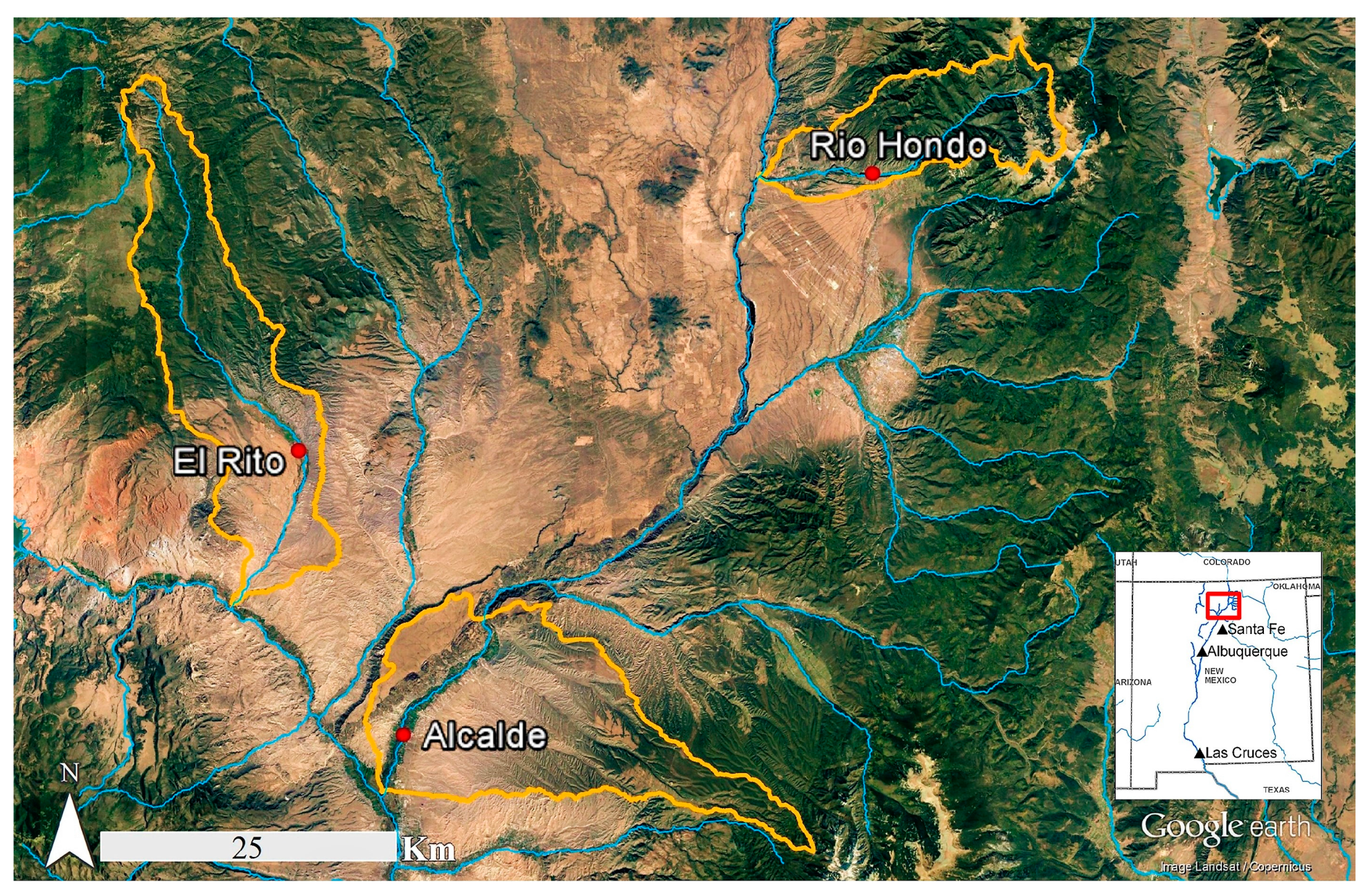

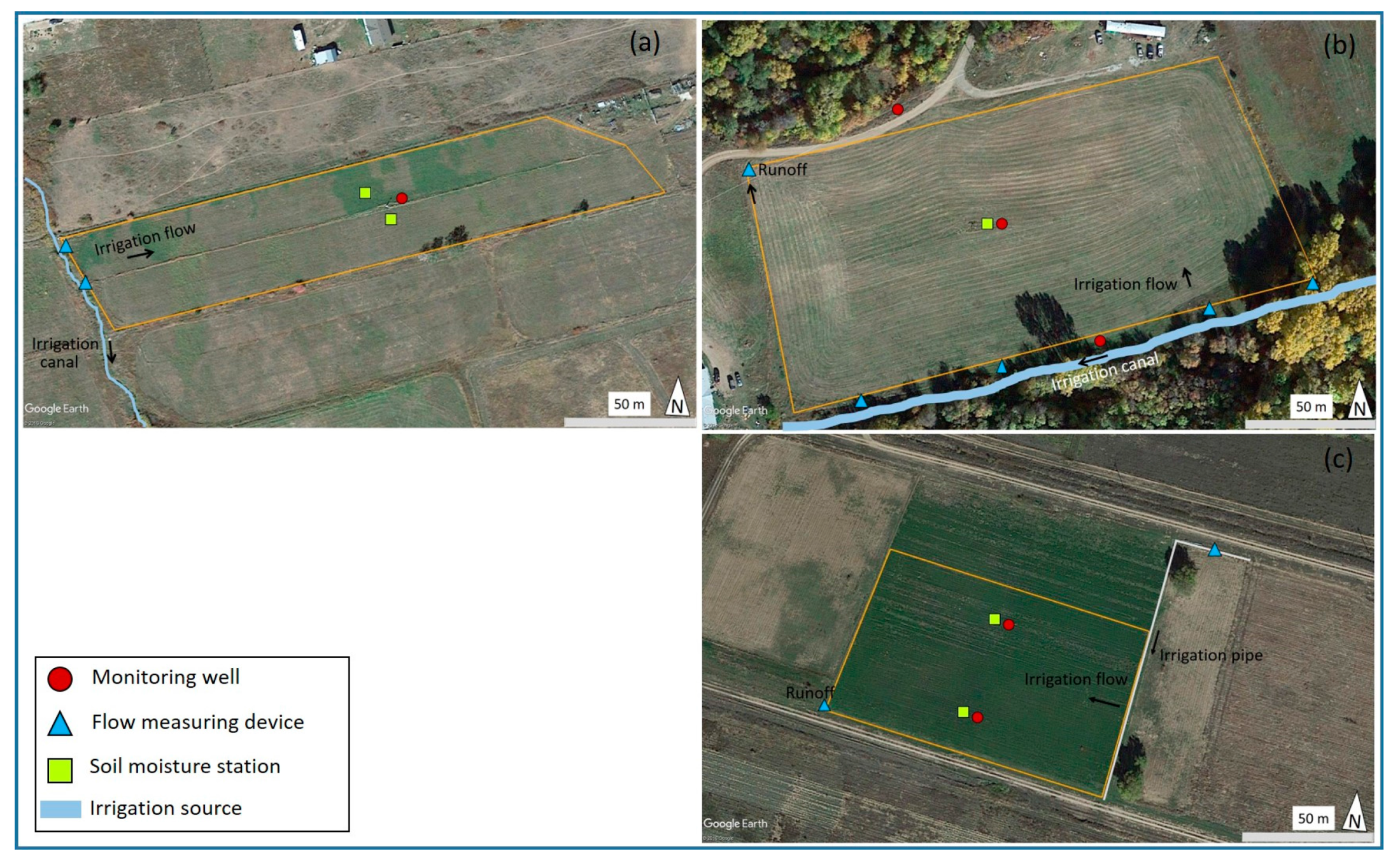
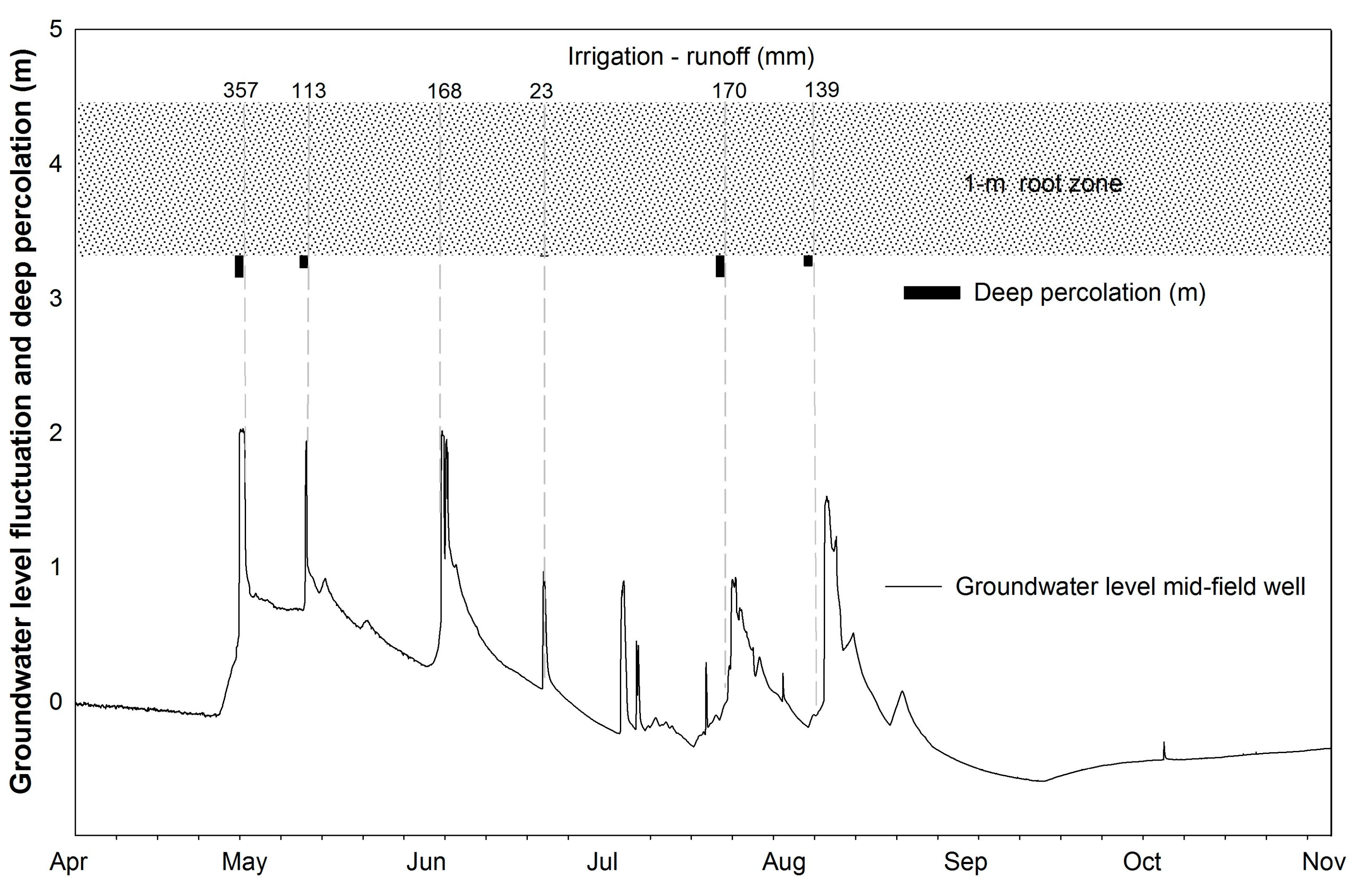
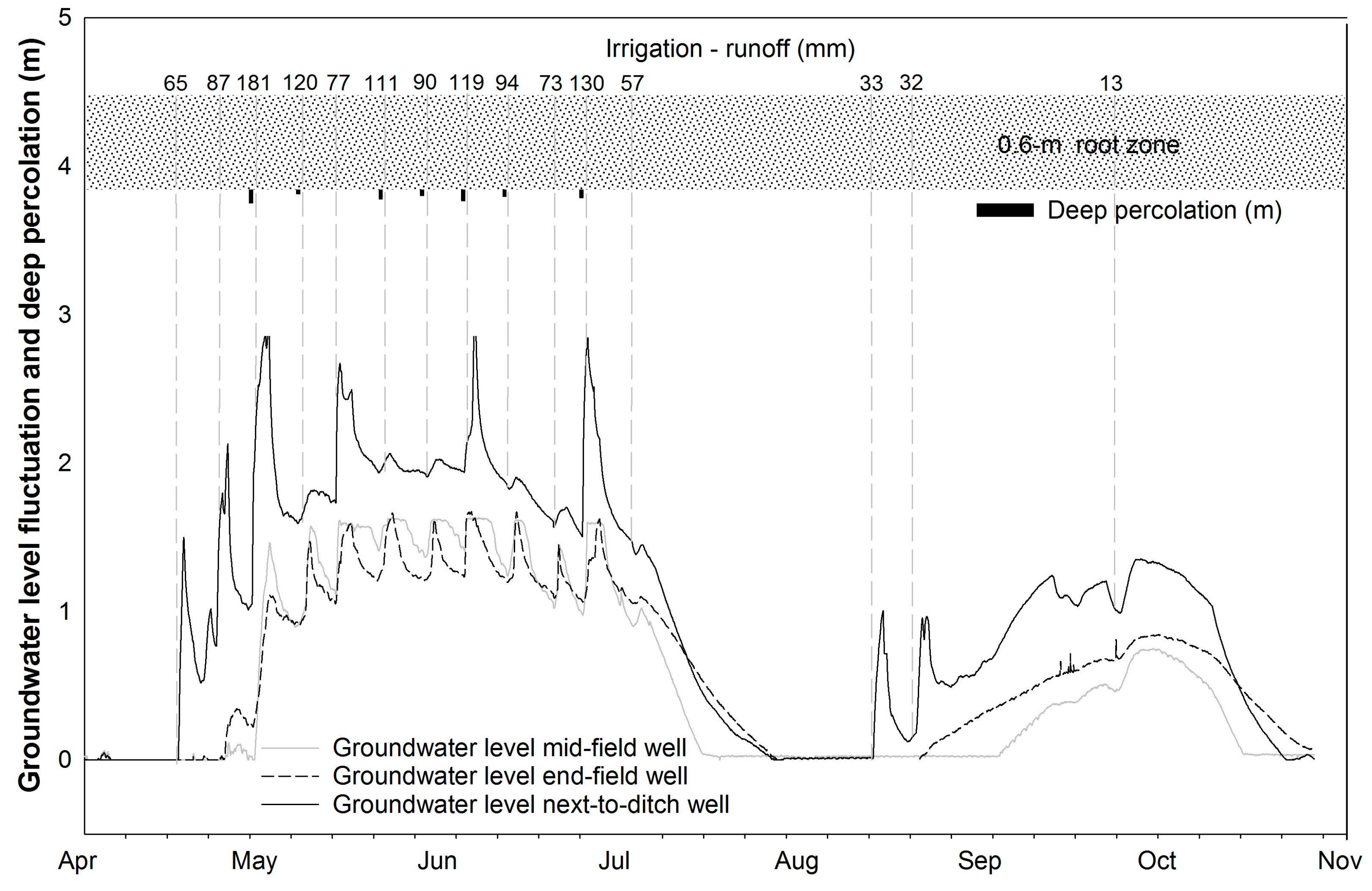
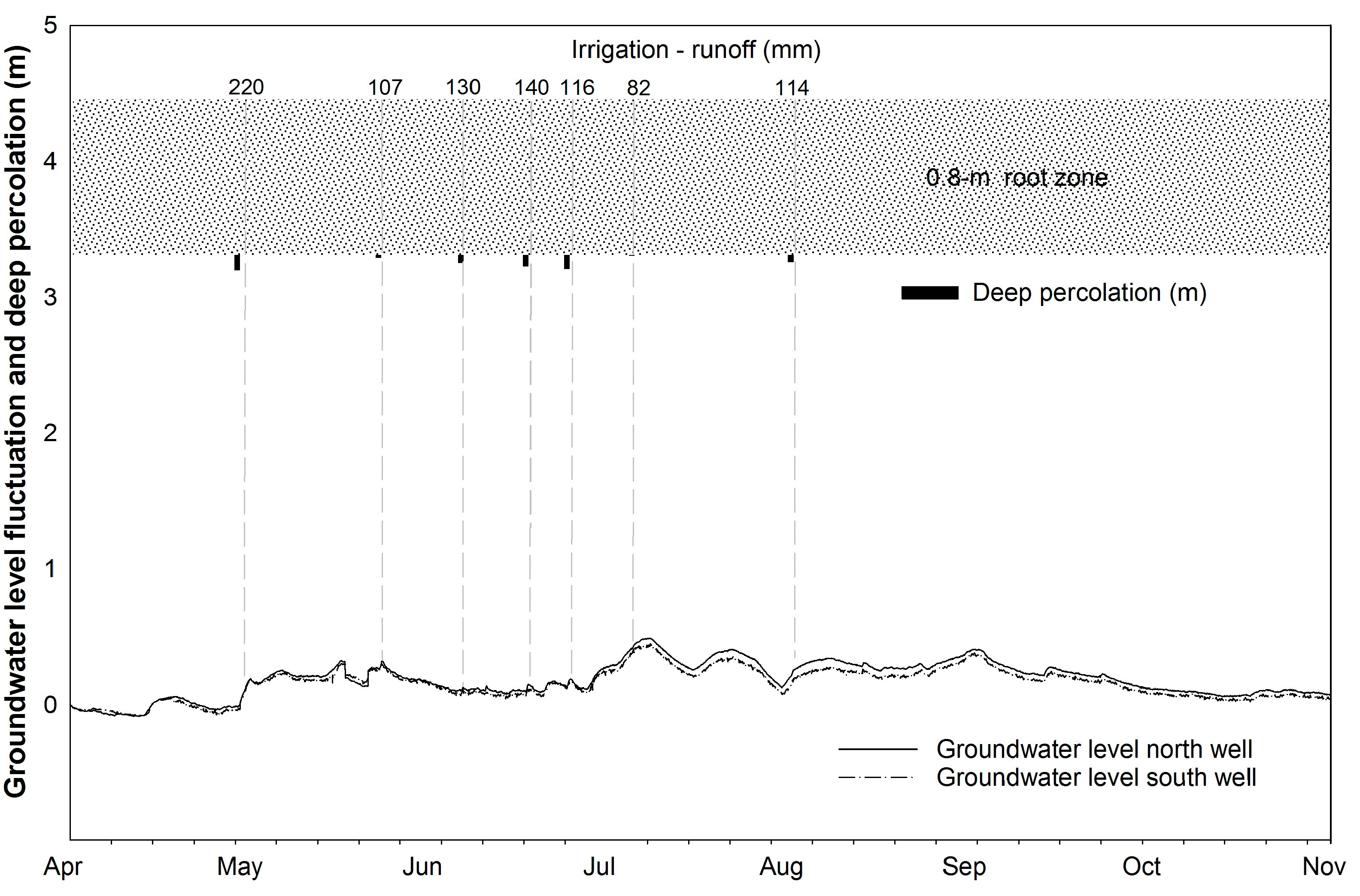
| Soil Depth | Bulk Density | Sand | Silt | Clay |
|---|---|---|---|---|
| (Mg·m−3) | (%) | (%) | (%) | |
| El Rito | ||||
| 0.1 m | 1.40 (0.06) | 55.3 (2.31) | 19.3 (1.15) | 25.5 (2.00) |
| 0.4 m | 1.34 (0.09) | 46.6 (4.02) | 19.9 (4.00) | 33.5 (4.00) |
| 0.8 m | 1.39 (0.12) | 54.6 (2.00) | 17.9 (0.02) | 27.5 (2.02) |
| 1.0 m | 1.45 (0.15) | 65.3 (2.30) | 13.3 (2.29) | 21.5 (0.02) |
| Rio Hondo | ||||
| 0.1 m | 1.59 (0.07) | 76.0 (1.09) | 13.9 (0.14) | 10.2 (1.15) |
| 0.3 m | 1.59 (0.04) | 75.4 (3.18) | 15.2 (2.42) | 9.4 (2.00) |
| 0.5 m | 1.49 (0.10) | 60.1 (1.10) | 25.2 (1.06) | 14.8 (1.17) |
| 0.8 m | 1.44 (0.08) | 51.4 (1.23) | 29.8 (0.12) | 18.8 (1.17) |
| Alcalde | ||||
| 0.1 m | 1.57 (0.11) | 78.2 (9.6) | 11.2 (6.4) | 10.6 (3.4) |
| 0.4 m | 1.56 (0.03) | 76.7 (0.4) | 11.9 (0.2) | 11.3 (0.3) |
| 0.8 m | 1.47 (0.13) | 62.9 (3.3) | 19.2 (2.9) | 17.9 (1.0) |
| 1.0 m | 1.41 (0.07) | 55.6 (7.9) | 19.8 (1.9) | 24.7 (6.0) |
| Date | IRR-RO Depth | Time between IRR | IRR Time | Ponding Time after End of IRR |
|---|---|---|---|---|
| (mm) | (Days) | (Hours) | (Hours) | |
| El Rito | ||||
| 28-April | 357.1 | N/A | 37 | 0 |
| 9-May | 112.8 | 11 | 40 | 0 |
| 1-June | 167.9 | 23 | 65 | 0 |
| 19-June | 23.2 | 18 | 15 | 0 |
| 19-July | 170.3 | 30 | 38 | 0 |
| 3-August | 139.4 | 15 | 88 | 0 |
| Average | 161.8 | 19.4 | 47.2 | 0 |
| Rio Hondo | ||||
| 16-April | 64.7 | N/A | 44 | 0 |
| 23-April | 86.7 | 7 | 44 | 0 |
| 29-April | 180.5 | 6 | 73 | 0 |
| 7-May | 120.4 | 8 | 49 | 5 |
| 13-May | 77.2 | 6 | 67 | 73 |
| 21-May | 111.2 | 8 | 47 | 61 |
| 28-May | 89.6 | 7 | 38 | 75 |
| 4-June | 119.1 | 7 | 49 | 67 |
| 11-June | 94.3 | 7 | 45 | 32 |
| 19-June | 72.8 | 8 | 24 | 0 |
| 24-June | 129.7 | 5 | 73 | 18 |
| 2-July | 56.8 | 8 | 39 | 0 |
| 12-August | 33.0 | 41 | 48 | 0 |
| 19-August | 32.0 | 7 | 60 | 0 |
| 22-September | 12.9 | 34 | 64 | 0 |
| Average | 85.4 | 11.4 | 50.9 | 22.1 |
| Alcalde | ||||
| 29-April | 219.9 | N/A | 32 | 0 |
| 23-May | 106.5 | 24 | 13 | 0 |
| 6-June | 129.7 | 14 | 8 | 1 |
| 17-June | 139.8 | 11 | 8 | 1 |
| 24-June | 115.8 | 7 | 8 | 2 |
| 5-July | 82.2 | 11 | 7 | 1 |
| 1-August | 114.0 | 27 | 8 | 2 |
| Average | 129.7 | 15.7 | 12.0 | 1.0 |
| Date | IRR | RO | PPT | Δθ | AET | DP |
|---|---|---|---|---|---|---|
| (mm) | (mm) | (mm) | (mm) | (mm) | (mm) | |
| El Rito | ||||||
| 28-April | 549.4 | 192.3 | 0.0 | 197.8 | 10.1 | 149.2 |
| 9-May | 173.5 | 60.7 | 5.1 | 22.3 | 8.6 | 87.0 |
| 1-June | 258.3 | 90.4 | 0.0 | 155.4 | 16.3 | 0.0 |
| 19-June | 35.7 | 12.5 | 0.0 | 6.5 | 11.4 | 5.4 |
| 19-July | 262.0 | 91.7 | 24.4 | 32.0 | 15.1 | 147.6 |
| 3-August | 214.4 | 75.0 | 26.7 | 68.2 | 25.1 | 72.8 |
| Average | 248.9 | 87.1 | 9.4 | 80.4 | 14.4 | 77.0 |
| Rio Hondo | ||||||
| 16-April | 64.7 | 0.0 | 0.0 | N/A | 9.8 | N/A |
| 23-April | 86.7 | 0.0 | 2.0 | N/A | 7.5 | N/A |
| 29-April | 185.3 | 4.7 | 0.0 | 55.8 | 17.3 | 107.4 |
| 7-May | 120.4 | 0.0 | 0.0 | 61.8 | 12.0 | 46.6 |
| 13-May | 96.5 | 19.3 | 0.5 | 44.6 | 31.4 | 1.7 |
| 21-May | 111.2 | 0.0 | 0.0 | 0.0 | 29.2 | 82.0 |
| 28-May | 89.6 | 0.0 | 0.0 | 3.0 | 28.6 | 58.0 |
| 4-June | 135.2 | 16.1 | 4.3 | 0.0 | 32.0 | 91.4 |
| 11-June | 94.3 | 0.0 | 1.0 | 6.8 | 24.1 | 64.4 |
| 19-June | 72.8 | 0.0 | 0.0 | 60.7 | 12.1 | 0.0 |
| 24-June | 131.3 | 1.9 | 5.6 | 33.6 | 30.0 | 71.7 |
| 2-July | 56.8 | 0.0 | 0.8 | N/A | 14.1 | N/A |
| 12-August | 33.0 | 0.0 | 0.5 | N/A | 14.2 | N/A |
| 19-August | 31.5 | 0.0 | N/A | N/A | N/A | N/A |
| 22-September | 12.9 | 0.0 | 26.9 | 20.4 | 12.0 | 7.5 |
| Average | 88.2 | 2.8 | 3.8 | 28.7 | 22.9 | 53.1 |
| Alcalde | ||||||
| 29-April | 224.3 | 4.4 | 0.0 | 105.9 | 14.9 | 99.1 |
| 23-May | 114.8 | 8.2 | 0.0 | 77.5 | 11.3 | 17.7 |
| 6-June | 134.7 | 4.9 | 0.0 | 69.6 | 8.7 | 51.4 |
| 17-June | 152.5 | 12.7 | 0.0 | 56.5 | 9.5 | 73.7 |
| 24-June | 157.3 | 41.5 | 0.0 | 13.8 | 10.9 | 91.1 |
| 5-July | 87.6 | 5.5 | 0.0 | 69.8 | 8.7 | 3.7 |
| 1-August | 119.7 | 5.7 | 3.8 | 64.4 | 8.6 | 44.8 |
| Average | 141.6 | 11.8 | 0.5 | 65.4 | 10.4 | 54.5 |
| El Rito | Rio Hondo | Alcalde | ||||||
|---|---|---|---|---|---|---|---|---|
| Date | Mid-Field | Date | Next to Ditch | Mid-Field | End of Field | Date | South | North |
| 28-April | 1724 | 16-April | 1499 | 45 | 23 | 29-April | 207 | 235 |
| 9-May | 1261 | 23-April | 1239 | 115 | 3 | 23-May | 63 | 59 |
| 1-June | 1626 | 29-April | 1868 | 1460 | 887 | 6-June | 24 | 38 |
| 19-June | 873 | 7-May | 217 | 657 | 559 | 17-June | 55 | 51 |
| 19-July | 1061 | 13-May | 942 | 512 | 549 | 24-June | 56 | 52 |
| 3-August | 1716 | 21-May | 105 | 127 | 388 | 5-July | 55 | 51 |
| - | - | 28-May | 120 | 257 | 409 | 1-August | 71 | 68 |
| - | - | 4-June | 1106 | 227 | 442 | - | - | - |
| - | - | 11-June | 79 | 379 | 474 | - | - | - |
| - | - | 19-June | 120 | 424 | 365 | - | - | - |
| - | - | 24-June | 1338 | 633 | 563 | - | - | - |
| - | - | 2-July | 67 | 123 | 48 | - | - | - |
| - | - | 12-August | 998 | 12 | NA | - | - | - |
| - | - | 19-August | 811 | 11 | 56 | - | - | - |
| - | - | 22-September | 363 | 26 | 142 | - | - | - |
| Average | 1377 | 725 | 349 | 350 | 76 | 79 | ||
© 2017 by the authors. Licensee MDPI, Basel, Switzerland. This article is an open access article distributed under the terms and conditions of the Creative Commons Attribution (CC BY) license ( http://creativecommons.org/licenses/by/4.0/).
Share and Cite
Gutiérrez-Jurado, K.Y.; Fernald, A.G.; Guldan, S.J.; Ochoa, C.G. Surface Water and Groundwater Interactions in Traditionally Irrigated Fields in Northern New Mexico, U.S.A. Water 2017, 9, 102. https://doi.org/10.3390/w9020102
Gutiérrez-Jurado KY, Fernald AG, Guldan SJ, Ochoa CG. Surface Water and Groundwater Interactions in Traditionally Irrigated Fields in Northern New Mexico, U.S.A. Water. 2017; 9(2):102. https://doi.org/10.3390/w9020102
Chicago/Turabian StyleGutiérrez-Jurado, Karina Y., Alexander G. Fernald, Steven J. Guldan, and Carlos G. Ochoa. 2017. "Surface Water and Groundwater Interactions in Traditionally Irrigated Fields in Northern New Mexico, U.S.A." Water 9, no. 2: 102. https://doi.org/10.3390/w9020102






